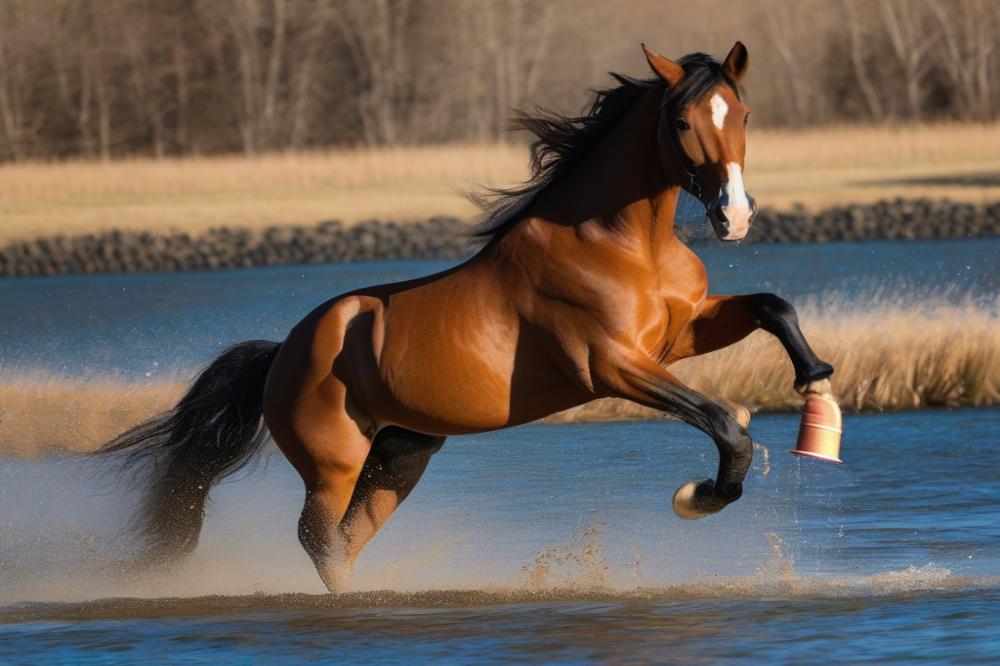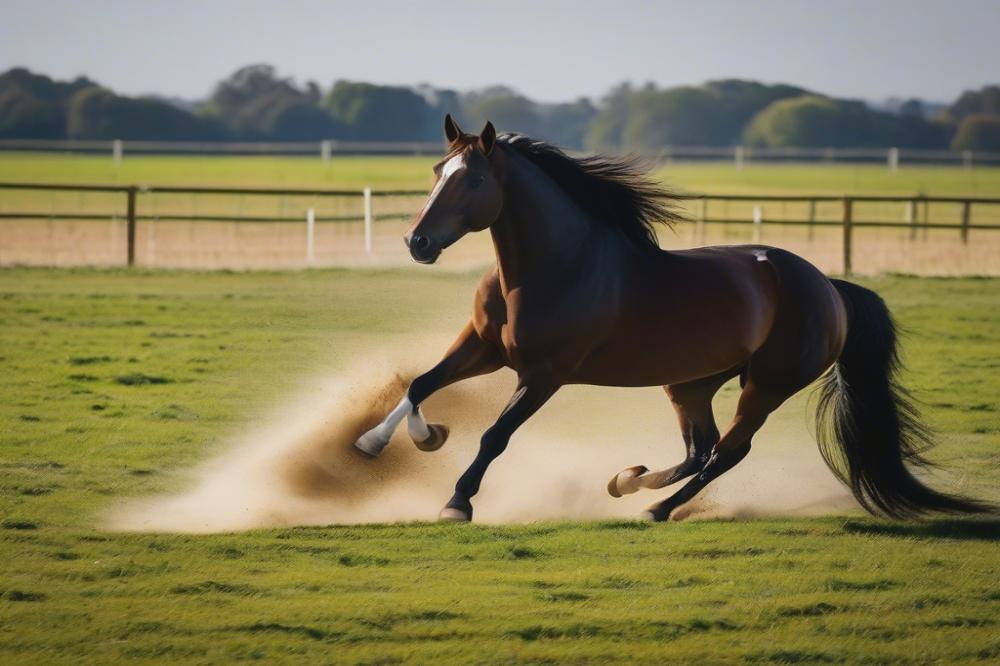Understanding the Danger of Horse Kicks
Ever wondered if a horse kick could actually be fatal? It’s a topic that raises eyebrows and evokes gasps, as the idea of such a large animal delivering a powerful blow can be quite alarming. Horses are majestic creatures, but with their strength and size, it’s crucial to understand the risks involved when handling these beautiful beasts. Many people interact with horses daily. Horse safety is a serious topic that deserves our attention, especially for anyone working or simply enjoying the company of these animals.
When we talk about horse behavior, we enter a world filled with quirks and mysteries. Horses have their own ways of communicating, and sometimes that can involve some surprising actions. For instance, did you know that even a playful kick can seriously harm someone? It’s not just about equine aggression; it’s about understanding what makes a horse tick. A horse may kick when frightened, annoyed, or even just as a way to say, “Hey, I’m feeling a bit sassy today!” Knowing when to give a horse its space or how to interpret its body language can save someone from injury.
Understanding the potential danger of a horse’s kick is vital for anyone working with these animals. You might think it’s just a casual day at the ranch, but ignoring the signs can lead to severe consequences. Imagine standing too close to a horse that feels cornered—it might see you as a threat. That’s when you need to be mindful of avoiding horse kicks! It’s easy to see a horse as a gentle giant, but they can react unpredictably if they feel threatened or uncomfortable.
In any discussion about handling horses, we should recognize the significance of educating ourselves about their behaviors. Just like maintaining a cautious distance from a bumblebee that seems agitated, staying aware of a horse’s mood can help prevent accidents. Whether you are an experienced rider or a beginner fascinated by the quarter horse temperament, always remember that knowledge is power. In the end, it comes down to respecting these animals, much like choosing the best trucks for towing horse trailers. You wouldn’t want to be caught in a tricky situation without understanding what you’re dealing with.
Understanding Horse Behavior

Horses are prey animals, which means they have an instinct to be on guard. They live in a world where predators lurk, ready to pounce. This instinct shapes their behavior in many ways. For example, when startled or threatened, a horse might react in ways that surprise us. Kicking is just one of those reactions.
Kicking often serves as a defense mechanism for these majestic creatures. Imagine a horse feeling cornered; the natural inclination is to fight or flee. Since running may not always be an option, a horse may choose to kick as a way to defend itself. This can happen when they feel trapped or scared. Understanding this can help you grasp why some horses may act aggressively.
Common Situations That May Lead to Kicking
Many factors can trigger kicking behavior. Sudden movements or loud noises can startle a horse. If you’ve ever walked up too quickly to a horse, you know the drill. They might shy away or, worse, kick out defensively. It’s a reaction born from fear. Knowing how to approach and handle horses safely goes a long way in avoiding mishaps.
Another situation arises during grooming. Horses don’t always enjoy being touched in certain spots. If you brush a sensitive area, a kick might come your way. Always check to see if a horse is comfortable where you are working. Recognizing their boundaries is crucial for horse safety.
Sometimes, horses kick when they feel their space is invaded, especially when food is involved. Imagine two horses at a feeding trough. One feels the other is getting too close. A swift kick could be the answer! This behavior is often linked to equine aggression over resources. Understanding horse behavior can help ensure everyone stays safe.
Being mindful of your surroundings is part of the equation. Loud noises, unexpected movements, or even other animals can provoke a horse’s kicking response. Keeping calm and staying aware can help you steer clear of horse kick injuries. Always remember, without understanding a horse’s natural instincts, you might find yourself on the receiving end of that kick.
Types of Kicks

Overview of Different Kicking Styles
Horses are not usually known for their combat skills, but they can deliver some serious kicks. Kicks come in various styles, and each type can be dangerous in its own way. Understanding how horses kick is essential for horse safety and handling horses effectively.
Some horses may kick straight out, while others can swing their legs back with force. Front kicks usually involve the horse lifting its front legs and striking forward. This type can happen unexpectedly, especially when a horse feels threatened. Hind kicks, however, are more common and can really pack a punch. When a horse kicks backward, it uses the power of its hindquarters, which are much stronger than the front. Knowing these differences helps in avoiding horse kicks and protecting yourself.
Front Kicks vs. Hind Kicks
It’s important to know the difference between front and hind kicks. A front kick can occur when a horse is feeling frisky or annoyed. Picture a horse in a playful mood; it might dart forward and lash out with its front legs. This might catch someone off guard. However, it’s generally not as powerful as a hind kick.
Now, the hind kick is where the real danger lies. These kicks come from the horse’s powerful back legs and can send a person flying if they’re at the wrong spot. Think of it like a cow poking you with its horns, but way faster. Hind kicks are often a horse’s instinctive reaction to something behind or below them. If a horse feels threatened from the rear, watch out!
Power and Speed Associated with Horse Kicks
Kicking can be a horse’s way of communicating warning signs, but it also comes with a hefty dose of power. The average horse can generate an impressive amount of force with its legs. Imagine a horse weighing about 1,000 pounds. Now, think about how much energy it would take to kick someone. It’s not pretty!
Speed is another factor. When a horse decides to kick, it doesn’t take time to think twice. Some kicks can happen in a split second. This can mean trouble if you’re in the line of fire. Horse behavior often includes signs of agitation before they kick. Signs like pinned ears or rapid tail swishes can warn you of their mood. Spotting these signs can help in avoiding horse kicks and reduce the risk of horse kick injuries.
So, as you nurture your passion for horses, remember that while they can be gentle giants, they also possess incredible strength. Understanding the types of kicks and the circumstances behind them will help you navigate the beautiful but occasionally dangerous world of equines. Respect their space, and always practice horse safety.
Instances of Horse Kick Injuries

Statistics on Horse-Related Injuries
Did you know that horse kick injuries can be surprisingly common? According to various studies, thousands of people are treated for such injuries every year. The hospital visits can sum up to thousands annually. Not everyone knows it, but horses can be quite dangerous if not handled properly. The American Association of Equine Practitioners reports numerous cases where improper interactions led to serious injuries. It’s a real eye-opener, showing the importance of horse safety.
Typical Injuries Caused by Kicks
Kicks from a horse can lead to several injuries. A person might suffer broken bones, bruises, or worse. Legs are often targets, but heads can also be at risk. Such injuries can occur from a startled horse or even during routine handling. Imagine getting kicked in the leg by a 1,000-pound animal. That can quickly ruin your day! Doctors say lower legs frequently break, leading to long recovery times. Others may experience internal injuries, which are more serious. Those situations get scary fast.
Real-Life Case Studies or Examples
Although we won’t delve into specific case studies here, let’s consider a hypothetical scenario. Imagine someone trying to calm a nervous horse. Suddenly, the horse reacts aggressively and kicks out. The person doesn’t see it coming. It’s a reminder of why understanding horse behavior is so crucial. Keeping a safe distance from any agitated horse can make all the difference. Practicing safe methods when handling horses is a must. Anyone working with them should know the risks involved. Being on alert can really help in avoiding horse kicks.
Factors Influencing Kick Danger
Horse Size and Breed Considerations
When it comes to horse kick injuries, size matters. Larger breeds like Clydesdales can pack a punch. A kick from one of these hefty animals can do serious damage. However, smaller breeds aren’t off the hook. Even a pony can deliver a kick that surprises you. Certain breeds are known for their temperament. Some, like Arabians, may be more prone to react aggressively. Understanding a horse’s unique behavior is key. Not every horse will kick, but knowing the breed can help you prepare.
Environmental Factors and Stress Levels
The environment plays a big role in horse behavior. Horses are sensitive creatures. Loud noises or sudden movements can cause stress. An agitated horse is more likely to kick. When horses feel threatened, they often respond with aggression. Keeping a calm environment is crucial for horse safety. Areas that are crowded or chaotic can trigger unwanted reactions. Just imagine a busy barn filled with people. It’s easy for a horse to feel nervous in that setting. Try to pay attention to the horse’s body language. Flattened ears or a twitching tail can be signs that something is off.
Human Behavior and Proximity to Horses
How humans behave around horses can change kick danger. Approaching a horse from behind might not be the best idea. Horses can’t see directly behind them well. That’s a recipe for disaster. Keeping a safe distance is essential. Should you come too close while the horse is startled, a kick might be on its way. Learning basic safety tips for handling horses can prevent accidents. It’s also about respect. A horse that feels safe won’t feel the need to defend itself. When people act calmly and confidently, the horse usually follows suit. Remember, a friendly connection goes a long way in avoiding horse kicks.
Preventing Kick Injuries
When it comes to horses, safety should never be an afterthought. Avoiding horse kicks is all about being smart and paying attention. First, always approach a horse from the front or the side. Sneaking up from behind can catch them off guard. You wouldn’t want someone creeping up on you either!
Handling horses requires mindfulness. Be aware of your surroundings and stick to calm settings. Busy places can lead to excitement, and excited horses might act unpredictably. Maintain your cool, so they feel assured around you. Like people, horses respond to calmness.
Safety Tips for Handling and Riding Horses
Using proper gear is essential for safe riding. Helmets, boots, and gloves can make a real difference. It’s also wise to have a buddy system. If you’re working with a horse, having someone else nearby can help in case things don’t go as planned. Imagine your friend as your safety net!
Avoiding sudden movements is another key point. Quick gestures can spook a horse. They may interpret a fast motion as a threat. Speak softly when near them. Just like humans, horses appreciate a gentle voice. Their ears will perk up when they hear reassuring tones.
Importance of Proper Training for Both Horses and Handlers
Training is crucial for both parties involved. Horses that receive consistent training are usually more predictable. A handler needs education too. Learning about horse behavior goes a long way. It helps you identify warning signs of equine aggression. That way, you can react quickly and safely.
Think of training as building a bridge of trust. The stronger that bridge, the less chance of accidents. A well-trained horse feels comfortable with commands and is less likely to kick. Every session is a step toward safety for you and your steed.
Understanding Horse Body Language
Reading horse body language is like deciphering a secret code. Their ears tell a story. If they are pinned back, that’s a red flag. You might be heading for trouble. A horse that stomps its feet is often showing discomfort or irritation. You don’t want to wait around to find out!
Observe their overall stance too. A relaxed horse stands tall with a loose demeanor. Tension in their muscles can mean they are on edge. Before getting too close, watch for signs of stress. Horses have a way of speaking without using words. You just need to tune in and listen.
What to Do After a Kick Incident
Immediate First Aid for Kick Injuries
In the event of a kick, staying calm is essential. Panic can make everything feel worse. Start by assessing the injury. If there’s bleeding, applying pressure with a clean cloth can help. Wash any wounds gently with soap and water to clean them up. Swelling often follows. Using an ice pack might reduce it, but remember to wrap it in a cloth. Rest is key. Keeping still can prevent further damage.
Sometimes, bruises appear quickly after the impact. These can be painful, but they usually heal on their own. However, don’t shrug off severe pain. If something feels very wrong, it’s better to be safe than sorry. Horse kick injuries vary, and not every bruise is just a bruise. Being attentive can make all the difference.
When to Seek Medical Attention
Certain signs should signal the need for professional help. If you see an open wound that looks deep, it’s time to visit a doctor. Dizziness, trouble breathing, or persistent pain are serious warning signs. There’s a chance of internal injuries, which are more concerning. Disorientation or confusion should never be ignored, either.
Pets can be unpredictable, and horse safety is crucial. Even if the injury seems minor at first, keep an eye on it. Sometimes issues manifest later, so better to check in with a healthcare provider. No one enjoys sitting in a waiting room, but your health matters most.
Psychological Impacts of Horse Kick Incidents
Injuries from a horse can be more than just skin deep. The mind often takes longer to heal than the body. Fear can linger long after the incident. You might find yourself a bit jumpy around horses. That’s normal. It’s essential to acknowledge these feelings. Talking to friends or family can help ease anxiety.
Sometimes, people may even avoid horses altogether after such an event. While it’s fine to take a break, remember not to let fear control you. Learning about horse behavior and understanding equine aggression can restore confidence. Knowledge can be empowering.
Consider seeking help from a counselor if feelings of anxiety persist. Different people process trauma in different ways. There’s no right or wrong way to feel. It’s okay to admit when you’re struggling. With time and support, many folks return to enjoying time around horses. It may take some work, but the bond with these magnificent animals is often worth it.
Wrapping Up the Insights on Horse Kicks
When we think about the sheer power a horse possesses, it’s easy to see just how dangerous a kick can be. Much like a freight train barreling down the tracks, a horse’s kick can inflict serious damage. Thankfully, most horse interactions don’t end in disaster, and that’s a comforting thought. But it’s wise to keep in mind that a horse doesn’t always know its own strength. Awareness is half the battle when it comes to protecting yourself and others around these magnificent animals.
By understanding the risks involved, one can take better precautions. It’s important to approach horses with respect and caution, treating them as the sensitive creatures they are. After all, do horses show affection to humans? Yes, they often do. With that affection comes a need for clear boundaries. Remember, a horse might not only be capable of love but also of fear. When frightened, they may react unpredictably, leading to unfortunate situations.
So, how do we stay safe while interacting with these giant friends? First off, always be aware of your surroundings. It’s like walking through a bustling market; you need to watch out for flying elbows and unexpected shoppers! Secondly, learn to read horse body language. When a horse pins its ears back, it’s giving you the clear message that it’s unhappy. This is the time to give it some space. Always approach from the front, never from behind, as that’s where surprise kicks can occur. Everyone enjoys a cold drink on a hot day; after all, even horses can be seen sipping horse drinking beer at events, but never forget: safety first. Keep your distance and respect their mood.
Final thoughts? Remember, building a relationship with a horse takes time and patience. Much like making a new friend, you want to earn their trust. It’s all about establishing a bond where they feel secure. This way, you not only enjoy your time with the animal but also minimize the risk of an unexpected encounter with those powerful hooves. Encourage safe practices and foster responsible interactions. With the right approach, you can enjoy countless happy moments without worrying about kicks or falls.



